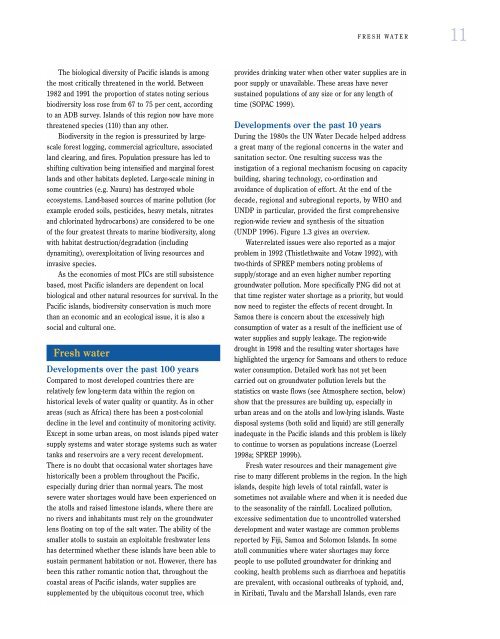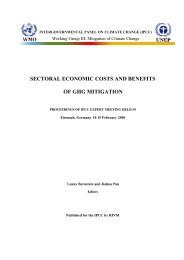Pacific Islands Environment Outlook - UNEP
Pacific Islands Environment Outlook - UNEP
Pacific Islands Environment Outlook - UNEP
You also want an ePaper? Increase the reach of your titles
YUMPU automatically turns print PDFs into web optimized ePapers that Google loves.
FRESH WATER 11<br />
The biological diversity of <strong>Pacific</strong> islands is among<br />
the most critically threatened in the world. Between<br />
1982 and 1991 the proportion of states noting serious<br />
biodiversity loss rose from 67 to 75 per cent, according<br />
to an ADB survey. <strong>Islands</strong> of this region now have more<br />
threatened species (110) than any other.<br />
Biodiversity in the region is pressurized by largescale<br />
forest logging, commercial agriculture, associated<br />
land clearing, and fires. Population pressure has led to<br />
shifting cultivation being intensified and marginal forest<br />
lands and other habitats depleted. Large-scale mining in<br />
some countries (e.g. Nauru) has destroyed whole<br />
ecosystems. Land-based sources of marine pollution (for<br />
example eroded soils, pesticides, heavy metals, nitrates<br />
and chlorinated hydrocarbons) are considered to be one<br />
of the four greatest threats to marine biodiversity, along<br />
with habitat destruction/degradation (including<br />
dynamiting), overexploitation of living resources and<br />
invasive species.<br />
As the economies of most PICs are still subsistence<br />
based, most <strong>Pacific</strong> islanders are dependent on local<br />
biological and other natural resources for survival. In the<br />
<strong>Pacific</strong> islands, biodiversity conservation is much more<br />
than an economic and an ecological issue, it is also a<br />
social and cultural one.<br />
Fresh water<br />
Developments over the past 100 years<br />
Compared to most developed countries there are<br />
relatively few long-term data within the region on<br />
historical levels of water quality or quantity. As in other<br />
areas (such as Africa) there has been a post-colonial<br />
decline in the level and continuity of monitoring activity.<br />
Except in some urban areas, on most islands piped water<br />
supply systems and water storage systems such as water<br />
tanks and reservoirs are a very recent development.<br />
There is no doubt that occasional water shortages have<br />
historically been a problem throughout the <strong>Pacific</strong>,<br />
especially during drier than normal years. The most<br />
severe water shortages would have been experienced on<br />
the atolls and raised limestone islands, where there are<br />
no rivers and inhabitants must rely on the groundwater<br />
lens floating on top of the salt water. The ability of the<br />
smaller atolls to sustain an exploitable freshwater lens<br />
has determined whether these islands have been able to<br />
sustain permanent habitation or not. However, there has<br />
been this rather romantic notion that, throughout the<br />
coastal areas of <strong>Pacific</strong> islands, water supplies are<br />
supplemented by the ubiquitous coconut tree, which<br />
provides drinking water when other water supplies are in<br />
poor supply or unavailable. These areas have never<br />
sustained populations of any size or for any length of<br />
time (SOPAC 1999).<br />
Developments over the past 10 years<br />
During the 1980s the UN Water Decade helped address<br />
a great many of the regional concerns in the water and<br />
sanitation sector. One resulting success was the<br />
instigation of a regional mechanism focusing on capacity<br />
building, sharing technology, co-ordination and<br />
avoidance of duplication of effort. At the end of the<br />
decade, regional and subregional reports, by WHO and<br />
UNDP in particular, provided the first comprehensive<br />
region-wide review and synthesis of the situation<br />
(UNDP 1996). Figure 1.3 gives an overview.<br />
Water-related issues were also reported as a major<br />
problem in 1992 (Thistlethwaite and Votaw 1992), with<br />
two-thirds of SPREP members noting problems of<br />
supply/storage and an even higher number reporting<br />
groundwater pollution. More specifically PNG did not at<br />
that time register water shortage as a priority, but would<br />
now need to register the effects of recent drought. In<br />
Samoa there is concern about the excessively high<br />
consumption of water as a result of the inefficient use of<br />
water supplies and supply leakage. The region-wide<br />
drought in 1998 and the resulting water shortages have<br />
highlighted the urgency for Samoans and others to reduce<br />
water consumption. Detailed work has not yet been<br />
carried out on groundwater pollution levels but the<br />
statistics on waste flows (see Atmosphere section, below)<br />
show that the pressures are building up, especially in<br />
urban areas and on the atolls and low-lying islands. Waste<br />
disposal systems (both solid and liquid) are still generally<br />
inadequate in the <strong>Pacific</strong> islands and this problem is likely<br />
to continue to worsen as populations increase (Loerzel<br />
1998a; SPREP 1999b).<br />
Fresh water resources and their management give<br />
rise to many different problems in the region. In the high<br />
islands, despite high levels of total rainfall, water is<br />
sometimes not available where and when it is needed due<br />
to the seasonality of the rainfall. Localized pollution,<br />
excessive sedimentation due to uncontrolled watershed<br />
development and water wastage are common problems<br />
reported by Fiji, Samoa and Solomon <strong>Islands</strong>. In some<br />
atoll communities where water shortages may force<br />
people to use polluted groundwater for drinking and<br />
cooking, health problems such as diarrhoea and hepatitis<br />
are prevalent, with occasional outbreaks of typhoid, and,<br />
in Kiribati, Tuvalu and the Marshall <strong>Islands</strong>, even rare

















